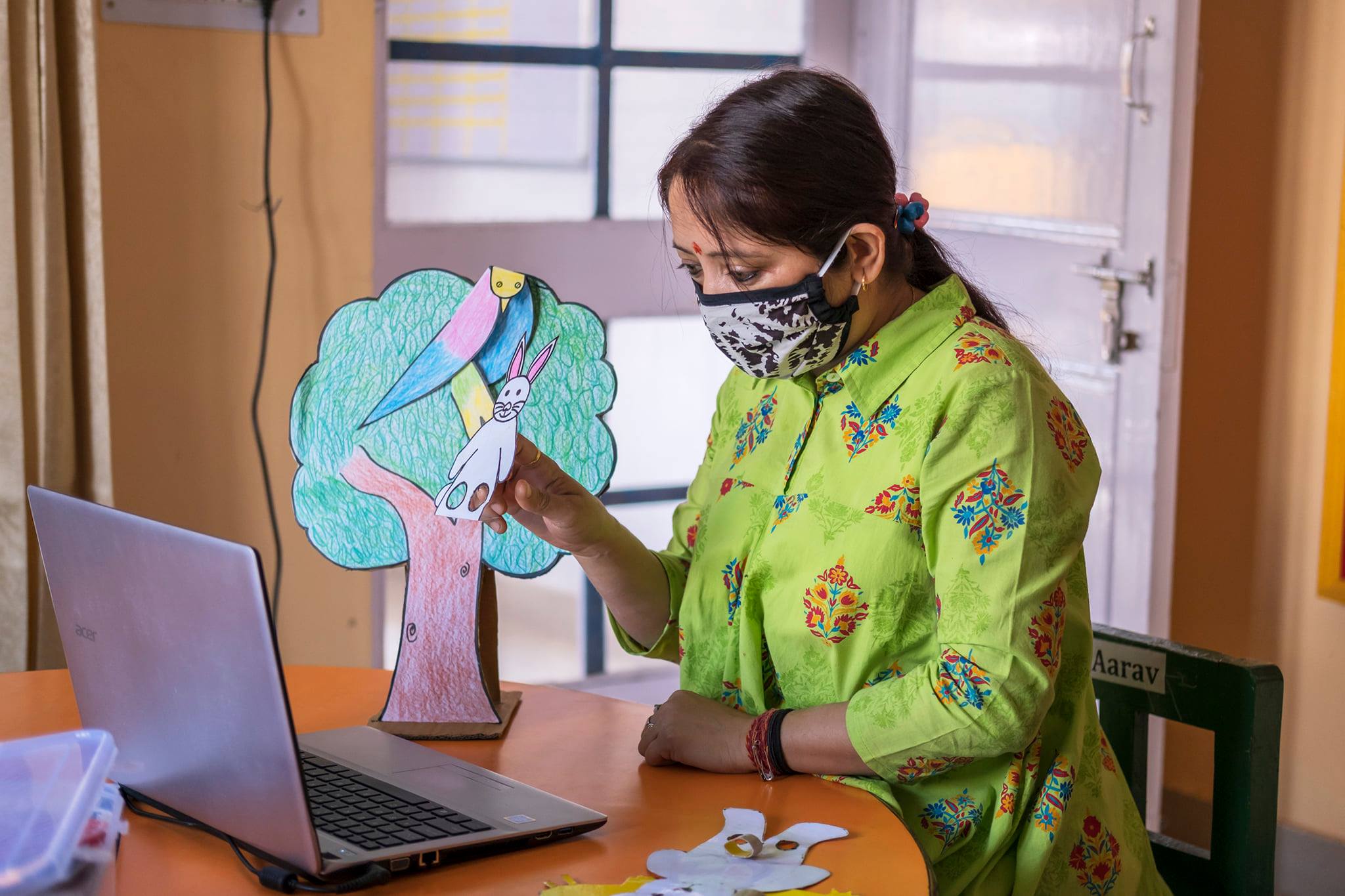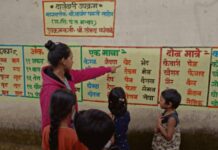The COVID-19 pandemic turned all our lives upside down—this is especially so for the Latika Roy Foundation (LRF). The Dehradun-based Foundation provides specialised, localised services to children with disabilities and their families in the city, and in rural and peri-urban areas of Uttarakhand.
With the onset of the lockdowns, the Foundation had to shut the doors of its in-person services without notice and shift to teleservices for children with disabilities instead. This challenging shift was initially fraught with technical concerns and logistical issues, leaving staff, parents, and children working from home with few learning aids at their disposal. “Initially, some parents were depressed as they were doing so much for their child’s education at home, but were unable to see any results,” says Anjali Mandal, a special educator with LRF.
Social distancing and physical restriction measures enforced during the pandemic have particularly affected children, both typical and disabled, in significant ways. Many studies have reported their negative influence on a child’s mental health, with increased anxiety, fear, stress, neglect and violence the unfortunate result.
Yet the barriers faced by disabled children and their families were magnified many times over in the pandemic due to the unexpected, non-inclusive lockdown measures—and the isolation they created. According to UNESCO, as of 2019, India is home to approximately 7.8 million children living with disabilities.
This discrimination exists partly because while some of the most visible disability rights movements focus on changing ableist habits and attitudes, the most harmful and persistent barriers persons with disabilities face are still distinctly structural. Children with disabilities still face significant barriers to social inclusion, equal opportunity, health and safety, and financial security—barriers that are erected from a very young age due to structural discrimination.
During the pandemic, access to information and safety advisories on COVID-19 was extremely limited, affecting disabled children’s learning. The additional isolation from structured therapy and intervention services strained friendships and social life.
Yet, with time, the Latika Roy Foundation initiated and implemented novel ways to connect and communicate with children and their parents during the pandemic—even to those who had no access to mobile phones, or who were in remote locations. The Foundation connected with more than 1,500 families between April of 2020 and March of 2021, providing virtual therapy, special education, and communication and counselling services. Its experiences of successfully engaging children with disabilities hinge on listening to the concerns of their parents and devising appropriate learning solutions for them. These insights can prove critical for other disability organisations navigating the present and future emergencies.
Identifying and Supporting Parents is the Key to Child Development
With the announcement of the first national COVID-19 lockdown in March of 2020, the Foundation closed. Yet, in the absence of in-person services, staff immediately came together to deliberate on ways to keep intervention services running uninterrupted virtually and through phone calls.
Initially, the Foundation’s staff began making phone calls to the children and their parents to check on them and to understand their immediate needs.
Parents were very anxious about their children not receiving assistive services and felt isolated and unsupported during this unpredictable period. Overnight, they were now expected to facilitate their child’s education, while also caring for them and their other children. “I’ve received around 800 calls from various parents during the Lockdown,” said Mahipal, child development aide at LRF. “They called up to say that they were unable to take care of their child at home. I used to connect them to the special educators and therapists at LRF. The calls were from districts across Uttar Pradesh and Uttarakhand.”
“We first called to gauge the economic conditions of the parents,” adds Manju Sharma, Project Head, Karuna Vihar Special School. “The parents asked questions like ‘how will we go to the hospital?’ or ‘what will we eat?’.”
Concerns over hospitalisation due to COVID-19 abounded during the pandemic—however, for people with disabilities, they were far more pronounced.
Thanks to the need for in-person caregiving and check-ups, the World Health Organization notes that persons with disabilities have been at a much higher risk of contracting COVID-19. The Lancet adds: “people with disabilities have been differentially affected by COVID-19 because of three factors: the increased risk of poor outcomes from the disease itself, reduced access to routine health care and rehabilitation, and the adverse social impacts of efforts to mitigate the pandemic.”
To address these initial concerns “we provided rations and the economic support that was needed at that time,” explains Sharma.
After these initial calls, many parents fell off the radar. “So, we decided to follow up with the parents in Dehradun through phone calls in April 2020,” shares Sandeep Khanna, LRF’s Project Head at Gubbara. “We made a list of parents who had contacted us in the last six months but did not come back for assessments. We made around 1,900 calls in total. We asked them how they were doing, how the child was, and then we spoke about [the need for] follow-ups. We also sent out videos to help them and they would also send us videos of their children. It was a positive interaction because parents were alone at home with children and could connect emotionally with us.”
The issues that cropped up during these calls indicated that parents needed support in different forms. Many of the parents who called were worried that the children might regress in terms of their learning and communication skills as a result of their limited teaching skills.

For some parents, digital literacy was a major hindrance to their child’s online learning. “Most of our parents did not know how to download Zoom,” recalls Sneha Mary Philip, a psychologist with LRF. “So, I started building companionship among parents through support groups, and we guided them through the initial stages [of Zoom sessions]. Parents slowly started interacting more—some mothers would even attend these sessions while cooking. I also taught them how to record their child’s activities and work.”
Tailoring Online Special Education to the Needs of Parents and Children at Home
Many parents faced behavioural problems while teaching and caring for their children at home. So, the LRF staff decided to focus more on developing more interactive and fun activities that engaged both the parents and children.
“We started holding virtual sessions. We first interacted with the children and their parents. Then we changed the goals we’d set for the children, focusing instead on learning goals that were achievable within their daily living activities. We made these goals [in consultation] with their parents,” says Manju Sharma.
“I had to research more to make the child’s activities productive as well as fun,” says Januka. “I used storytelling to teach children number values and also used poems to help them understand size-related concepts of ‘big and small’. Depending on the interests of the child, I had to change my explanation approach. There certainly was an increase in videos sent via WhatsApp between the parents and me since we could not observe each other in person. The advantage of these one-on-one online sessions was that they brought all the families closer to me. I was able to build on our relationship even more.”

Anju Khanna, a physiotherapist with LRF, also facilitated deeper connections with both students and parents through her classes. “I used my own child as a model for the parents, to make them understand different postures or how to move the child,” she says. “The parents felt empowered [as this was something they could easily understand and execute]. We used things that were easily available at home to help the children. We asked them to use boxes placed on top of a bed or pillars to help them stand properly.”

Educators also used these activities to enable the social and emotional learning that takes place in school.“We held a picnic day on Zoom and made sure there was some space in each child’s home to enjoy it,” explains Sunita K. Singh, Project Head of LRF’s Child Development Center. “We found children who could become each other’s buddies and organised peer interaction sessions, which my son was part of too. We included their other friends and cousins in the sessions [to widen the group].”
Nirmala, a communication specialist with LRF, adds, “we also spoke to the families about how communication [while teaching] is not just about speaking a sentence or a word. It is also about gestures and signs. Parents loved interacting with their children as a result. The added benefits were that grandparents and other family members also spent more time communicating with the child.”
Some parents struggled with managing this transition from caregiver to educator more than others. Januka, a special educator with LRF explains how this played out. “I had a parent who was staying alone with her child. She wanted to just talk to a friend. I used to call her often and gave her name to the Foundation so that they could provide her with ration supplies. I had her meet our counsellor and then slowly started holding hands-on training with her and the child virtually. By the end of the sessions, the child was able to independently eat food.”
Preparing for the Future

According to the families we work with, the weekly calls became a lifeline for most during the worst stages of the pandemic. Their troubles are not likely to ease any time soon. As the world reopens, very few countries made vaccination accessible to people with disabilities, or have ensured sufficient protections for these at-risk groups when lockdowns were lifted. Once, people with disabilities and their caregivers will have to contend with an uncertain future.
The pandemic has taught us many lessons on being creative and thinking out of the box as we deliver services for disabilities online. With continued threats of new variants and possible lockdowns in the future, a hybrid model of disability services, provided both in-person with safety precautions and online as well, can nurture meaningful connections between professionals and children and foster lifelong education.
As we design these action plans, our message remains the same:
Diversity is a Fact. Equity is a decision. Inclusion is an action. Belonging is the result.
Featured image: a special educator holding a virtual class; courtesy of the Latika Roy Foundation; pictures used in this piece were shared with parental consent.






